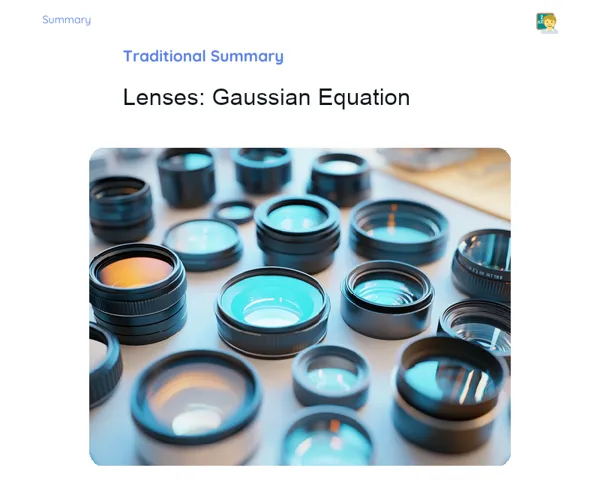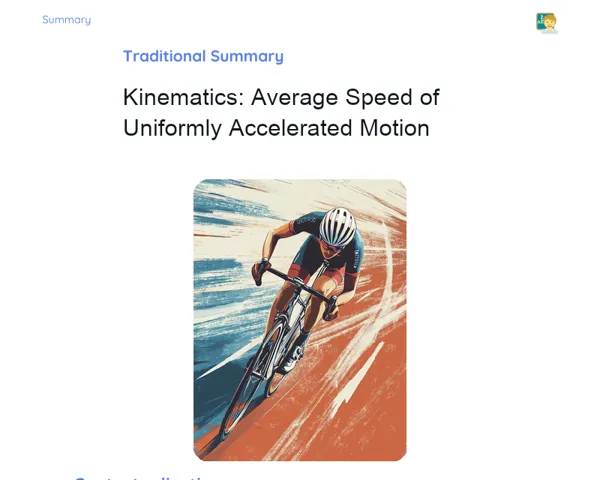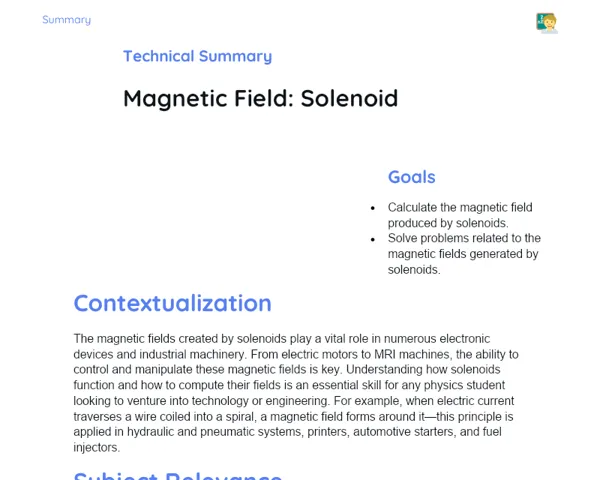Summary Tradisional | Work: Elastic Potential Energy
Contextualization
Elastic potential energy is one of the basic ideas in physics, describing the energy stored in elastic objects like springs when they are either stretched or compressed. This energy is key to understanding how many mechanical systems work – from simple toys we use daily to sophisticated engineering mechanisms. The energy is given by the formula E = (1/2) * k * x^2, where E stands for the elastic potential energy, k is the spring (or elastic) constant, and x represents the amount of deformation. We also see this concept in everyday use, such as in click pens and trampolines, where the spring stores energy when squeezed or pulled and then releases it to do useful work.
To get the full picture of elastic potential energy, it is important to also recall Hooke's Law. This law explains that the restoring force that a spring exerts is directly proportional to the deformation it undergoes, expressed as F = -k * x. The negative sign indicates that the force acts in the opposite direction to that of the deformation, trying to bring the spring back to its original state. Representing this relationship as a straight line on a graph (with force on the y-axis and deformation on the x-axis) makes it easier to understand and interpret. By studying this linear behavior, we can discern important points on the axes and appreciate the proportionality between force and deformation, a concept that has plenty of practical applications in everyday life.
To Remember!
Elastic Potential Energy
Elastic potential energy is the energy that gets stored in materials that can be deformed, for example, springs when they are either stretched or compressed. How much energy is stored depends on the spring’s constant and how much it has deformed. We calculate this energy using the formula E = (1/2) * k * x^2, where E is the energy, k is the elastic or spring constant (typically in N/m), and x is the amount of deformation (in metres).
This stored energy is what allows many mechanical systems to perform work. Take a click pen, for instance; compressing its spring stores energy which is then released to extend the pen tip. Similarly, in trampolines, the energy stored in the stretched or compressed mat helps to bounce a person upward.
Beyond these everyday examples, elastic potential energy plays a significant role in engineering and physics. It is crucial for designing vehicle suspension systems, calculating energy in elastic materials, and even in some energy storage applications. A solid grasp of this concept is fundamental to understanding how various mechanical systems function and how their efficiency can be enhanced.
-
Energy stored in objects that can change shape.
-
Key formula: E = (1/2) * k * x^2.
-
Wide applications in everyday gadgets and engineering designs.
Hooke's Law
Hooke's Law states that the restoring force a spring exerts is proportional to the amount by which it has been deformed. Mathematically, it is expressed as F = -k * x, where F is the restoring force (in Newtons), k is the spring constant, and x is the deformation (in metres). The negative sign indicates that this force acts in the opposite direction of the deformation, working to bring the spring back to its original shape.
This principle is vital for predicting how elastic materials react under different forces. It is widely used in numerous fields including the design of suspension systems in vehicles, as well as in analysing the structural response of various materials and constructions.
Moreover, Hooke's Law is very handy when it comes to plotting the relationship between force and deformation on a graph. The equation F = -k * x produces a straight line when plotted, with force on the y-axis and deformation on the x-axis. Such graphs are very useful in analysing experimental data and understanding the elastic properties of materials.
-
The restoring force is directly linked to the deformation.
-
Expressed by the equation: F = -k * x.
-
Widely implemented in both physics problems and engineering designs.
First-Degree Function
The connection between the force exerted by a spring and its deformation can be neatly represented by a first-degree (linear) function. The equation F = -k * x is essentially a straight line of the form y = mx + b, where m (the slope) is -k and b (the y-intercept) is zero in this case.
This linear representation greatly helps in visualizing data and analysing the performance of elastic systems. By plotting the data, one can easily identify the intercepts on both the x and y axes and see how changes in the elastic constant affect the spring's performance. The slope, being equal to -k, gives us an indication of how stiff the spring is – a larger k means a steeper slope and a stiffer spring.
Overall, using a straight-line graph to represent this relationship is a powerful method for interpreting experimental results and for predicting how elastic systems will behave under different conditions.
-
Represents a straight-line equation: y = mx + b.
-
The slope corresponds to the spring's elastic constant.
-
Helps in visual data analysis and understanding experiment results.
Table Interpretation
Being able to interpret data from tables is a vital skill when examining the relationship between force and deformation in elastic systems. Often, tables provide values for these variables that can be used to calculate the elastic constant (k) and plot the function F = -k * x.
While looking at a data table, it is very helpful to identify where the graph intercepts the axes. For instance, the y-axis intercept occurs when there is no deformation, and thus, no force is applied; similarly, the x-axis intercept occurs when the force is zero. These key points make it easier to understand the overall linear relationship.
Additionally, analyzing tables helps in checking the consistency of experimental data and spotting any discrepancies. Matching the measured values with those predicted by Hooke's Law not only validates the experiment but also deepens our understanding of the material’s elastic characteristics.
-
Crucial for understanding the link between force and deformation.
-
Involves identifying key intercept points on the axes.
-
Helps verify the consistency and accuracy of experimental data.
Key Terms
-
Elastic Potential Energy: The energy stored in elastic objects when they are deformed.
-
Hooke's Law: Describes the proportional relationship between the restoring force and the amount of deformation.
-
First-Degree Function: A straight-line representation of the force-deformation relationship.
-
Elastic Constant (k): A measure of how stiff a spring is.
-
Restoring Force: The force that tries to bring a deformed spring back to its original state.
-
Deformation (x): The change in shape or size of a spring due to the applied force.
Important Conclusions
In this lesson, we delved into the concept of elastic potential energy – the energy stored in objects when they are deformed, like in the case of springs. We learned how to calculate this energy using the formula E = (1/2) * k * x^2 and explored its practical applications, both in everyday devices and in engineering contexts. A good understanding of this concept is key to appreciating how various mechanical systems operate and how their performance can be optimised.
We also examined Hooke's Law, which outlines the direct relationship between the restoring force and the deformation of a spring, represented by F = -k * x. This law is indispensable for predicting the behavior of elastic materials and is extensively applied in fields such as physics and engineering. Representing this relationship on a graph as a straight line further helps in visualising and analysing experimental data.
Lastly, we highlighted the importance of interpreting data from tables to grasp the force-deformation relationship in elastic systems. Such analysis allows us to verify experimental results and gain deeper insights into the characteristics of the materials studied. This comprehensive approach equips us to apply theoretical knowledge to practical scenarios and solve real-life engineering challenges more effectively.
Study Tips
-
Review the key concepts and formulas discussed in class, and try solving extra problems on elastic potential energy and Hooke's Law.
-
Make use of graphs and tables to visually connect the relationship between force and deformation, which will aid in understanding experimental data and theories.
-
Explore additional resources like educational videos and interactive simulations to further strengthen your grasp on elastic potential energy and its applications.



